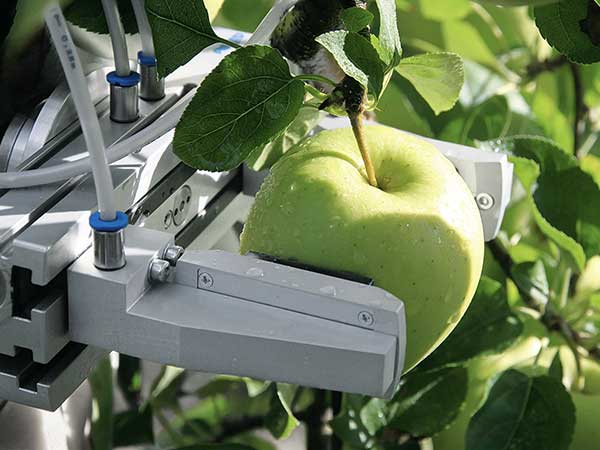
Agricultural robots are revolutionizing the way we harvest crops and manage nurseries. These machines address several challenges faced by the agriculture industry. Firstly, they mitigate the effects of labor shortages. Many traditional farm tasks are physically demanding and can be difficult to fill, especially during peak harvest seasons. Robots can tirelessly work long hours, ensuring efficient harvesting and reducing reliance on manual labor.
Secondly, agricultural robots improve the quality and yield of crops. Advanced sensors allow robots to precisely identify ripe produce, leading to more selective harvesting and minimizing damage to delicate fruits and vegetables. In nurseries, robots can automate tasks like seeding, transplanting, and watering with greater precision than manual methods, fostering healthier plant growth and potentially increasing yields.
Finally, agricultural robots promote sustainability in farming practices. Precise harvesting techniques employed by robots can reduce waste and the need for harsh chemicals. Nursery robots can optimize water usage and minimize reliance on pesticides, contributing to more environmentally friendly agricultural practices. Overall, agricultural robots are poised to transform the way we cultivate and harvest our food, ensuring a more efficient, productive, and sustainable future for agriculture.
In this post, we list some of the top agricultural robots for harvesting and nursery tasks.
1. Harvest Automation HV-100
Harvest Automation’s HV-100 is an autonomous mobile robot designed to tackle repetitive tasks in nurseries and greenhouses. It can operate both indoors and outdoors, making it suitable for wholesale greenhouses, hoop houses, and traditional nurseries. The HV-100 automates material handling, specifically focusing on the task of efficiently spacing containerized plants – a common chore in these settings.
With the HV-100, growers can expect to see significant gains in productivity and overall efficiency. The robot helps address labor shortages, allowing human workers to focus on higher-value tasks. Additionally, the HV-100 can improve plant quality through optimized plant placement and potentially reduce non-labor costs associated with water, fertilizers, and pesticides. Harvest Automation is continuously improving the HV-100 and exploring its application in other agricultural sectors like fruit and vegetable production.
2. Agrobot SW6010
Agrobot SW6010 is a robotic strawberry harvester designed to address the challenges of labor shortages and delicate fruit handling. The SW6010 utilizes computer vision and machine learning to identify ripe strawberries based on size, color, and other parameters. Equipped with 30 robotic arms, the machine carefully cuts the stem and places the strawberry onto a conveyor belt, minimizing damage. The independent robotic arms allow the machine to function even if one arm malfunctions. Additionally, Agrobot emphasizes the SW6010’s simple and sturdy construction, keeping maintenance costs down.
3. Root A.I. developed by Root Robotics
Root A.I. developed by Root Robotics specializes in creating autonomous robots for harvesting tasks within greenhouses, specifically focusing on tomatoes. Their first robot targets cherry tomato picking, but their aim is to expand to other crops. Root A.I. robots utilize cameras and machine learning to identify ripe tomatoes and precisely maneuver to pick them without damaging the fruit or the plant. The robots automate the harvesting process, reducing reliance on manual labor, a growing challenge in the agricultural sector.
4. Cotton-picking robot by Green Robot Machinery
This cotton-picking robot, developed by India-based agricultural technology company Green Robot Machinery which focuses on precision farm machinery solutions to address challenges faced by farmers, with their main product being an autonomous cotton picking machine, utilizes a combination of stereo cameras, machine learning algorithms, and robotic arms to identify and pick cotton bolls with high precision, minimizing damage to the plant and reducing reliance on manual labor. Designed for semi-autonomous operation on electric farm vehicles, the cotton picker can potentially cover large fields efficiently. Green Robot Machinery is currently exploring the applicability of their technology to the harvesting of other crops besides cotton, such as okra, eggplant, and tomatoes.
5. FFRobot by FFRobotics
The FFRobot by FFRobotics is a multi-armed harvesting platform designed to mimic the careful picking process of human hands. FFRobotics emphasizes bruise-free fruit harvesting, which is important for maintaining fruit quality. The robots use image recognition software to identify and select fruit based on criteria like ripeness. The FFRobot can be modified to harvest different types of fruits, making it a versatile solution for various seasons. While the 10,000 apples per hour figure might be an optimistic target, FFRobotics’ technology has the potential to significantly improve the efficiency and reduce the labor required for fruit harvesting.
6. MetoMotion’s GRoW
MetoMotion’s GRoW is an autonomous greenhouse robot designed to address the challenges of labor shortages and improve efficiency in tomato harvesting. It performs autonomous harvesting of tomatoes within greenhouses and operates 24/7 thanks to advanced night vision systems and smart battery systems. Its 3D vision systems identify ripe tomatoes based on size, color, and other factors. Dual robotic arms harvest from both sides of greenhouse rows simultaneously, while specially designed grippers ensure damage-free picking. The robot is powered by AI and sophisticated software that analyzes plant data to optimize harvesting strategies and predict yields, allowing farmers to make informed decisions for improved crop management.
7. Berry by Organifarms
Berry by Organifarms is a game-changer for strawberry growers. This innovative robot automates the harvesting process within greenhouses, eliminating the need for manual labor. Equipped with smart sensors and cameras, Berry can identify ripe strawberries and carefully harvest them with its robotic arm, all without harming the delicate fruit. This not only improves the overall quality of the harvest but also allows for 24/7 operation, significantly increasing efficiency and productivity. By reducing reliance on manual labor and potentially harmful chemicals, Berry also presents a more sustainable solution for strawberry farming.






















